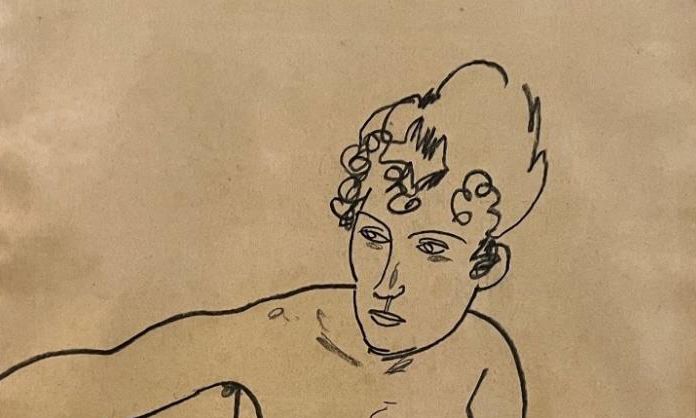Detail of Egon Schiele's Seated Nude Woman (1918) Photo: Courtesy the Manhattan District Attorney's Office
This morning (26 July), the Manhattan District Attorney’s Office hosted what Matthew Bogdanos, chief of its Antiquities Trafficking Unit, called a “celebration”—returning a Nazi-looted Egon Schiele drawing to heirs of Fritz Grünbaum, an Austrian Jewish cabaret performer and art collector who was murdered at Dachau in 1941.
“As a boss, you’re not supposed to have a favourite,” Bogdanos said at the restitution ceremony, “but there are some cases and some days where the tragedies were so great and the joys so real, that it is a fool’s errand to pretend that it is just another day at the office. And this is one of those days.”
The drawing, Seated Nude Woman (1918), was made less than year before Schiele’s death and is thought to depict his wife, Edith. It had been in the possession of the Papanek family, Austrian Jews who had successfully fled the Nazis in 1938 and bought the work decades later without any knowledge of its history. After growing suspicious of its provenance in recent years, the Papaneks specifically sought out Grünbaum’s heirs in order to “do the right thing” and return the work.
Members of the Grünbaum and Papanek families were present at the ceremony. “Both of these families have been deeply impacted by the Holocaust,” District Attorney Alvin L. Bragg said during the event. “It is particularly moving for me to be here alongside them.”
Seated Nude Woman was purchased in Manhattan by Helene and Ernst Papanek and given to their son, Gustav, in 1969. It was after Gustav’s death in 2022 that his relatives began their research into the drawing’s provenance.
Egon Schiele's Seated Nude Woman (1918) Photo: Courtesy the Manhattan District Attorney's Office
Speaking on behalf of the Papaneks, Gustav’s son-in-law Rocco Orlando called the whole ordeal a “bittersweet irony of two families with a history of great harm and suffering because of the Holocaust. Helene and Ernst Papanek, who acquired this drawing, did so to connect themselves to their Viennese roots, to the roots of Austrian Expressionism.” He added that Ernst had been a “prominent socialist reformer”, who during the Second World War helped Jewish children flee Austria and Germany.
Seated Nude Woman is one of more than 80 Schiele works taken from Grünbaum and his family by the Nazis. Because Schiele’s art was deemed “degenerate” by the regime, the pieces were sold abroad and the proceeds used to fund the war. Most of Grünbaum’s Schieles eventually found their way to Galerie St. Etienne in New York City. The gallery’s founder, Otto Kallir, personally sold Seated Nude Woman to the Papaneks for $4,000 in 1961, according to Tom Mashberg in The New York Times.
The drawing will now head to Christie’s. The Grünbaum heir Paul Reif noted at the ceremony that, like with other works returned to the family, proceeds from the sale would go to the Grünbaum Fischer Foundation “to support young, wonderfully talented and underprivileged performing artists”.
Marc Porter, chairman and head of restitution at Christie’s, said in a statement: “Christie’s is thrilled to play its part in the growing legacy of Fritz Grünbaum and his heirs. Today, another work of art that belonged to Fritz is rightfully restituted to his family, and as the auction house with the largest restitution department in the world, Christie’s looks forward to offering this piece in the near future.” (Christie’s has sold a number of other Schieles restituted to the Grünbaum heirs over the years.)
This marks the Manhattan DA’s third restitution ceremony and 11th work returned to the Grünbaum family. Since September 2023 alone, five US museums and four private collections have returned works to the family. Grünbaum’s is now the biggest Holocaust art-restitution case in the US. A spat between the Manhattan DA’s Office and the Art Institute of Chicago over the rightful ownership of a Schiele drawing of a war prisoner once belonging to Grünbaum is slowly making its way to court.
Since its inception in 2017, the Antiquities Trafficking Unit has held 93 repatriation and restitution ceremonies and recovered more than 5,500 works worth more than $450m to 35 countries and individuals. The unit has also convicted 16 people of cultural-property trafficking and filed extraditions for six others.

